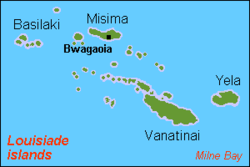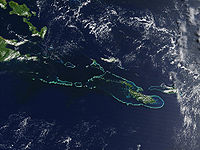
Louisiade Archipelago
Encyclopedia


New Guinea
New Guinea is the world's second largest island, after Greenland, covering a land area of 786,000 km2. Located in the southwest Pacific Ocean, it lies geographically to the east of the Malay Archipelago, with which it is sometimes included as part of a greater Indo-Australian Archipelago...
, stretching over more than 160 kilometres (99.4 mi) and spread over an ocean area of 26000 square kilometre between the Solomon Sea
Solomon Sea
The Solomon Sea is a sea located within the Pacific Ocean. It lies between Papua New Guinea and the Solomon Islands. Many major battles were fought there during World War II.-Extent:...
to the north and the Coral Sea
Coral Sea
The Coral Sea is a marginal sea off the northeast coast of Australia. It is bounded in the west by the east coast of Queensland, thereby including the Great Barrier Reef, in the east by Vanuatu and by New Caledonia, and in the north approximately by the southern extremity of the Solomon Islands...
to the south. The aggregate land area of the islands is about 1790 square kilometre, with Vanatinai (Tagula)
Vanatinai
Vanatinai or Tagula is a volcanic island in the south-east of the Louisiade Archipelago within Milne Bay Province of Papua New Guinea. The reef fringed island is approximately south-east of New Guinea. With an area of , it is the largest island of the archipelago. Vanatinai town, the main...
being the largest.
Sideia Island
Sideia Island
Sideia Island is an island in the Louisiade Archipelago in Milne Bay Province, Papua New Guinea. It is located East of the end of New Guinea mainland. Its area is 107 km²....
and Basilaki Island
Basilaki Island
Basilaki Island is an island in the Louisiade Archipelago in Milne Bay Province, Papua New Guinea. It is located at the eastern end of the New Guinea mainland. Its area is 100 km2.- References :http://islands.unep.ch/...
lie closest to New Guinea, while Misima
Misima Island
Misima is a volcanic island in the northwest of Louisiade Archipelago within Milne Bay Province of Papua New Guinea. The island measures 40 km by 10 km and has an area of 202,5 km². It is located some 20 km north of the northwest extreme of the barrier reef of Vanatinai at Isu Raua Raua Island,...
, Vanatinai, and Rossel islands lie further east.
The archipelago is divided into the Local Level Government (LLG) areas Louisiade Rural (western part, with Misima), and Yaleyamba (western part, with Rossell and Vanatinai islands). The LLG areas are part of Samarai-Murua District
Samarai-Murua District
Samarai-Murua District is a district of the Milne Bay Province of Papua New Guinea. Its capital is Murua. The population of the district was 42,855 at the 2000 census....
district of Milne Bay
Milne Bay Province
Milne Bay is a province of Papua New Guinea. Its capital is Alotau. The province covers 14,000 km² of land and 252,990 km² of sea, within the province there are more than 600 islands, about 160 of which are inhabited...
. The seat of the Louisiade Rural LLG is Bwagaoia on Misima Island, the population center of the archipelago.
Islands
The Louisiade Archipelago consists of the following island groups and islands :- Bonvouloir Islands (East, Hastings, Strathord islands)
- Calvados Chain (Bagaman, Hemenahei, Kuwanak, Motorina, Panatinane, Panawina islands)
- Daloloia Group (Auriora, Conflict Group, Lunn islands)
- Deboyne IslandsDeboyne IslandsThe Deboyne Islands are a group of reefs and islands off the north of Louisiade Archipelago, Papua New Guinea. They are located 13 km from Misima and 5 km from the Torlesse Islands...
(Panaeati, Panapompom islands) - Renard Islands
- Misima IslandMisima IslandMisima is a volcanic island in the northwest of Louisiade Archipelago within Milne Bay Province of Papua New Guinea. The island measures 40 km by 10 km and has an area of 202,5 km². It is located some 20 km north of the northwest extreme of the barrier reef of Vanatinai at Isu Raua Raua Island,...
- Rossel Island
- Vanatinai Island (alternatively Tagula)
- Yeina Island
History
The islands were most likely observed by Luis Váez de Torres in 1606, but Malay and Chinese sailors may have visited the islands earlier. Louis Antoine de BougainvilleLouis Antoine de Bougainville
Louis-Antoine, Comte de Bougainville was a French admiral and explorer. A contemporary of James Cook, he took part in the French and Indian War and the unsuccessful French attempt to defend Canada from Britain...
named them in 1768 for Louis XV
Louis XV of France
Louis XV was a Bourbon monarch who ruled as King of France and of Navarre from 1 September 1715 until his death. He succeeded his great-grandfather at the age of five, his first cousin Philippe II, Duke of Orléans, served as Regent of the kingdom until Louis's majority in 1723...
, the king of France
France
The French Republic , The French Republic , The French Republic , (commonly known as France , is a unitary semi-presidential republic in Western Europe with several overseas territories and islands located on other continents and in the Indian, Pacific, and Atlantic oceans. Metropolitan France...
. Visits were also paid by Admiral Bruni d'Entrecasteaux
Bruni d'Entrecasteaux
Antoine Raymond Joseph de Bruni d'Entrecasteaux was a French navigator who explored the Australian coast in 1792 while seeking traces of the lost expedition of La Pérouse....
in 1793 and Captain Owen Stanley
Owen Stanley
Captain Owen Stanley FRS RN was a British Royal Navy officer and surveyor.-Life:Stanley was born in Alderley, Cheshire the son of Edward Stanley, rector of Alderley and later Bishop of Norwich...
in 1849. The 1942 Battle of Coral Sea was fought nearby, after Japanese occupation in the same year.
Louisiade Archipelago rain forests
The islands have a moist tropical climate, and are largely covered with tropical moist broadleaf forests. The Louisiade Archipelago rain forests form a distinct ecoregionEcoregion
An ecoregion , sometimes called a bioregion, is an ecologically and geographically defined area that is smaller than an ecozone and larger than an ecosystem. Ecoregions cover relatively large areas of land or water, and contain characteristic, geographically distinct assemblages of natural...
, and are home to a number of endemic
Endemic (ecology)
Endemism is the ecological state of being unique to a defined geographic location, such as an island, nation or other defined zone, or habitat type; organisms that are indigenous to a place are not endemic to it if they are also found elsewhere. For example, all species of lemur are endemic to the...
species, including several endemic trees (in genera Pandanus
Pandanus
Pandanus is a genus of monocots with about 600 known species. They are numerous palmlike dioecious trees and shrubs native of the Old World tropics and subtropics. They are classified in the order Pandanales, family Pandanaceae.-Overview:...
, Diospyros
Diospyros
Diospyros is a genus of about 450–500 species of deciduous and evergreen trees. The majority are native to the tropics, with only a few species extending into temperate regions. They are commonly known as ebony or persimmon trees...
, and Hopea
Hopea
Hopea is a genus of plant in family Dipterocarpaceae. The genus was named after John Hope, 1725-1786, the first Regius Keeper of the Royal Botanic Garden, Edinburgh. It contains about 104 species, distributed from Sri Lanka and southern India to southern China, and southward throughout Malesia to...
), as well as five endemic frog
Frog
Frogs are amphibians in the order Anura , formerly referred to as Salientia . Most frogs are characterized by a short body, webbed digits , protruding eyes and the absence of a tail...
species, two endemic lizard
Lizard
Lizards are a widespread group of squamate reptiles, with nearly 3800 species, ranging across all continents except Antarctica as well as most oceanic island chains...
species, and five endemic bird
Bird
Birds are feathered, winged, bipedal, endothermic , egg-laying, vertebrate animals. Around 10,000 living species and 188 families makes them the most speciose class of tetrapod vertebrates. They inhabit ecosystems across the globe, from the Arctic to the Antarctic. Extant birds range in size from...
species.

